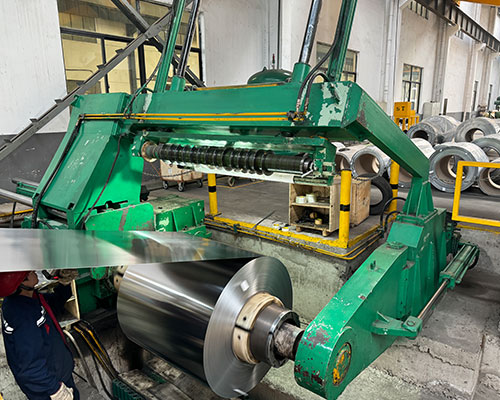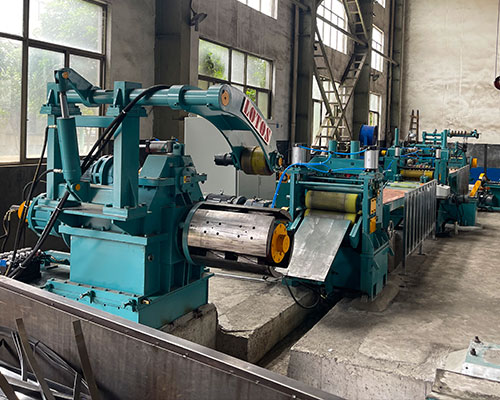Thin Steel Coil Slitting Line
The Thin Gauge Slitting Line is one of the essential pieces of equipment in the process of preparing thin metal sheets. This line is specifically designed for precise, fast, and damage free cutting of sheets with low thickness. It is widely used in industries where high precision, delicate handling, and surface quality preservation are critical. The mechanical design and control system of this line ensure that even the thinnest sheets are slitted with high accuracy, preventing any wrinkling or tearing, and converting them into smaller, well formed rolls.
Ligth Duty Metal Slitting Line
The process begins with the uncoiling of the coil by the Uncoiler. The sheet then passes through the Leveling Unit, where internal stresses are eliminated, and a uniform surface is achieved. Next, the sheet enters the Slitting Unit, where it is precisely slitted into strips of specified widths with a cutting tolerance of ±0.05 mm using high precision blades. This stage is carried out with utmost care to prevent any cutting errors or warping.
The slitted strips are then guided by the guiding systems, stretched, and fed into the Recoiler section, where they are re wound into narrower coils. At the end of the process, the output coils are prepared for packaging and transportation. This line is fully automated and, with the help of a PLC control system and an industrial user interface, allows for easy adjustment, precise monitoring, and quick execution of the slitting operation.
Light Gauge Slitting Line
The Thin Gauge Slitting Line stands out for its high speed performance, ±0.05 mm cutting tolerance, and ability to process delicate and thin metal sheets with exceptional precision.This makes it an ideal solution for electronics, appliance manufacturing, and precision metalworking industries.
With minimized material waste and enhanced cutting accuracy, the line boosts production efficiency and supports cost effective manufacturing. Its optimized design not only improves final product quality but also helps businesses lower operational costs, making it a smart choice for manufacturers focused on precision slitting, thin material processing, and production scalability.

Questions :
1. How does the Thin Gauge Slitting Line ensure precision cutting of such thin materials?
Answer:
The Thin Gauge Slitting Line utilizes high-precision blades, a robust leveling unit, and a highly accurate control system to ensure that even the thinnest metal sheets are slit with an accuracy of ±0.05 mm. The advanced control system and mechanical design help prevent issues like wrinkling, tearing, or surface damage during the cutting process.
2. What types of metals can be processed with this slitting line?
Answer:
This slitting line is ideal for processing thin metal sheets such as aluminum, copper, stainless steel, galvanized steel, and other thin metal alloys. It is designed for materials with a thickness range of 0.2 mm to 2.0 mm and is suitable for industries requiring high precision and surface quality.
3. What industries typically use the Thin Gauge Slitting Line?
Answer:
The Thin Gauge Slitting Line is widely used in industries where high precision, delicate handling, and surface preservation are critical. These industries include electronics, appliance manufacturing, precision metalworking, automotive parts production, and thin metal processing in general.
4. What kind of maintenance is required for the Thin Gauge Slitting Line, and how often does it need servicing?
Answer:
The Thin Gauge Slitting Line is designed for low-maintenance operation. Regular maintenance includes checking and replacing the blades, inspecting the leveling unit, and ensuring the control system is functioning optimally. We recommend performing preventive maintenance every 3 to 6 months, depending on the usage. Our service team provides support and spare parts as needed.
5. How does the Thin Gauge Slitting Line minimize material waste and improve cutting accuracy?
Answer:
The Thin Gauge Slitting Line is designed to minimize material waste and enhance cutting accuracy through its advanced control system and high-precision blades. By maintaining tight tolerances and preventing issues such as warping or tearing, the line ensures that materials are processed efficiently with minimal waste, improving overall product quality and production efficiency.

